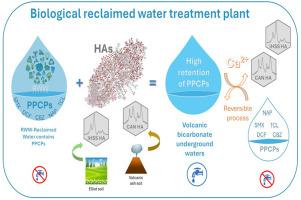Impacts of soil humic acids on the presence of PPCPs in reclaimed water
IF 7.3
2区 环境科学与生态学
Q1 ENVIRONMENTAL SCIENCES
引用次数: 0
Abstract
A multidisciplinary approach investigates the interaction between selected PPCPs with diversified physicochemical propertiesand humic acids (HAs) extracted from Elliot and volcanic soils in reclaimed water (RW). Principal component analysis (PCA) reveals significant differences between the two HAs and how these differences affect PPCP-HA interaction which are characterized by UV spectroscopy. The sorption of PPCPs on either IHSS HA or CAN HA fit a pseudo-second-order kinetic reaction in RW, indicating that the adsorption rate was controlled by the diffusion of the PPCP, followed by adsorption on the HA surface. The sorption of each individual PPCP on both HAs was characterized by applying sorption isotherm models, showing that chemisorption is involved. Moreover, the simultaneous PPCP-HA interactions between the selected PPCPs and both HAs in RW (at different pHs) fitted Freundlich's model (R2 > 0.9890), where, KF values are 0.0003 and 0.085 for simultaneous adsorption on IHSS HA and CAN HA, respectively. The greater KF value obtained for CAN HA suggests that the simultaneous PPCP adsorption is more favourable in this HA than in IHSS HA. Meanwhile, coexisting Ca2+ (>50 mM) in RW could inhibit the PPCP–HA interaction due to the aggregation of HAs. This study highlights the importance of the HA origin in the interaction with PPCPs in RW, which can affect the fate and transport of these pollutants and the associated environmental risk.

土壤腐植酸对再生水中PPCPs存在的影响
多学科方法研究了具有多种物理化学性质的PPCPs与从再生水(RW)中提取的腐植酸(HAs)之间的相互作用。主成分分析(PCA)揭示了两种ha之间的显著差异,以及这些差异如何影响PPCP-HA相互作用,并通过紫外光谱进行了表征。在RW中,PPCP在IHSS HA和CAN HA上的吸附均符合准二级动力学反应,表明PPCP的吸附速率受PPCP的扩散控制,然后在HA表面吸附。应用吸附等温线模型对各PPCP在两个HAs上的吸附进行了表征,表明其参与了化学吸附。此外,所选的PPCPs与RW中两种HA(不同ph值)同时发生的PPCP-HA相互作用符合Freundlich模型(R2>0.9890),其中IHSS HA和CAN HA同时吸附的KF值分别为0.0003和0.085。CAN HA获得的KF值较大,表明该HA比IHSS HA更有利于PPCP的同时吸附。同时,RW中共存的Ca2+ (>50 mM)由于HAs聚集而抑制PPCP-HA相互作用。本研究强调了河西中HA来源与PPCPs相互作用的重要性,它可以影响这些污染物的命运和运输以及相关的环境风险。
本文章由计算机程序翻译,如有差异,请以英文原文为准。
求助全文
约1分钟内获得全文
求助全文
来源期刊

Environmental Pollution
环境科学-环境科学
CiteScore
16.00
自引率
6.70%
发文量
2082
审稿时长
2.9 months
期刊介绍:
Environmental Pollution is an international peer-reviewed journal that publishes high-quality research papers and review articles covering all aspects of environmental pollution and its impacts on ecosystems and human health.
Subject areas include, but are not limited to:
• Sources and occurrences of pollutants that are clearly defined and measured in environmental compartments, food and food-related items, and human bodies;
• Interlinks between contaminant exposure and biological, ecological, and human health effects, including those of climate change;
• Contaminants of emerging concerns (including but not limited to antibiotic resistant microorganisms or genes, microplastics/nanoplastics, electronic wastes, light, and noise) and/or their biological, ecological, or human health effects;
• Laboratory and field studies on the remediation/mitigation of environmental pollution via new techniques and with clear links to biological, ecological, or human health effects;
• Modeling of pollution processes, patterns, or trends that is of clear environmental and/or human health interest;
• New techniques that measure and examine environmental occurrences, transport, behavior, and effects of pollutants within the environment or the laboratory, provided that they can be clearly used to address problems within regional or global environmental compartments.
 求助内容:
求助内容: 应助结果提醒方式:
应助结果提醒方式:


